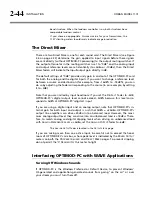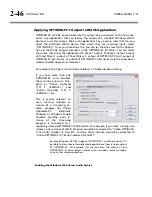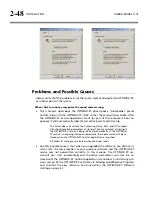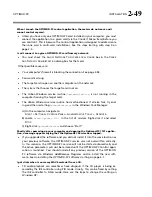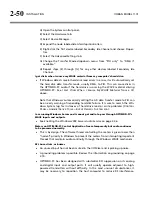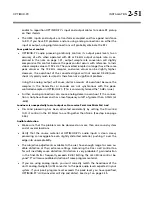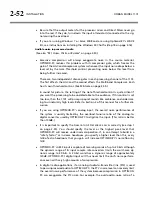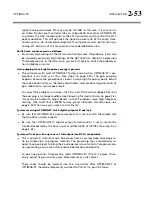
2-42
INSTALLATION
ORBAN MODEL 1101
•
Adjusting MB Limiter Drive changes the Loudness Level meter’s indication and
the amount of gain reduction in the loudness controller and peak limiter.
Setting Preset Loudness Correctly in Dolby Digital Transmissions
If you are processing for a Dolby Digital distribution channel and wish to customize
a factory preset, be aware of two major philosophies, one presented in ATSC Rec-
ommendation A/85 and the other in EBU Recommendation R 128.
ATSC A/85:
If you wish to ensure that dialog levels are consistent from one program
segment to the next, use the 1101’s CBS loudness
meter as a reference for adjusting
a user preset’s loudness. In this case, we prefer relying on the CBS Loudness Control-
ler to do final loudness control and turning the BS.1770 Safety Limiter off. Consis-
tent loudness of the “anchor element” (usually dialog) is the goal suggested in ATSC
Recommendation A/85, which is the basis for CALM Act compliance, and we prefer
this goal to strictly relying on the BS.1770-2 loudness meter.
EBU R 128:
If you wish to ensure that integrated loudness as measured on a
BS.1770-2 meter is consistent from one piece of program material to the next, use
OPTIMOD-PC’s BS.1770-2 loudness meter as a reference. In this case, you may wish to
active OPTIMOD-PC’s BS.1770 Safety Limiter, which will constrain BS.1770-2 loudness
with a 10-second integration time from exceeding the setting of the
BS.1770
T
HRESHOLD
control. However, note that R128 encourages mixing to achieve a wide
dynamic range, where some material may considerably exceed the target loudness
when measured on a “short-term” (three-second integration time; ungated)
BS.1770-2 meter. Moreover, R 128 requires online loudness control to be defeated if
upstream material is known to be pre-processed such that the integrated loudness
of each program segment (per BS.1770-2) is identical to the active dialnorm value
with a
±
1 dB window. You can use OPTIMOD-PC’s control API (see Section 6 of this
document) to switch the output source between either
D
IRECT
M
IXER
(which sets the
bypass gain) and
P
ROCESSOR
M
IXER
W
ITH
L
IMITER
(which provides the loudness-
controlled output). See step 6 starting on page 2-26 for a detailed discussion of set-
up.
See
Using the ITU BS.1770 and CBS Loudness Meters to Measure Loudness Controller
starting on page 3-73 for a comparison of the ATSC A/85 and EBU R
128 philosophies of loudness control.
The CBS and BS.1770-2 loudness meters’ calibrations track the 1101’s active
D
IALNORM
value, which is either the
D
IALNORM
R
EFERENCE
(which applies to any preset whose
D
IALNORM
value is set to
G
LOBAL
)
or the
D
IALNORM
value in the active processing pre-
set if this value is not set to
G
LOBAL
.
The loudness meters are only calibrated to
D
IALNORM
if the Dialnorm
R
EFERENCE
S
OURCE
in
I/O
M
IXER
>
C
ONFIGURATION
is not set
O
FF
. If it is set
O
FF
, the
L
OUDNESS
M
ETER
S
ENSITIVITY
control becomes active. This control allows you to scale the loud-
ness meter’s sensitivity so that it indicates on-scale and is mainly useful to allow you
to compare the loudness of the 1101’s “radio-style” presets and to assess the effect
of customizing those presets.
Summary of Contents for Optimod-PC 1101
Page 4: ......
Page 14: ......
Page 121: ...OPTIMOD PC OPERATION 3 1 Section 3 Operation Figure 3 1 The OPTIMOD PC Control Application...
Page 192: ...3 72 OPERATION ORBAN MODEL 1101...
Page 204: ......
Page 210: ......
Page 212: ...5 2 UNINSTALLATION ORBAN MODEL 1101...
Page 236: ......

















